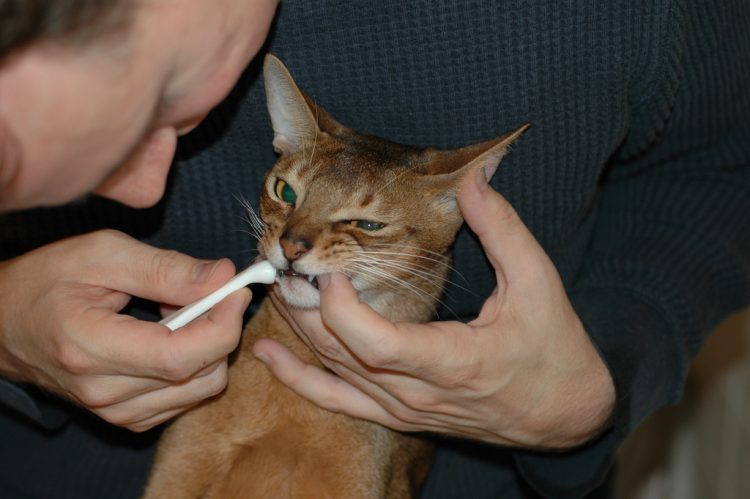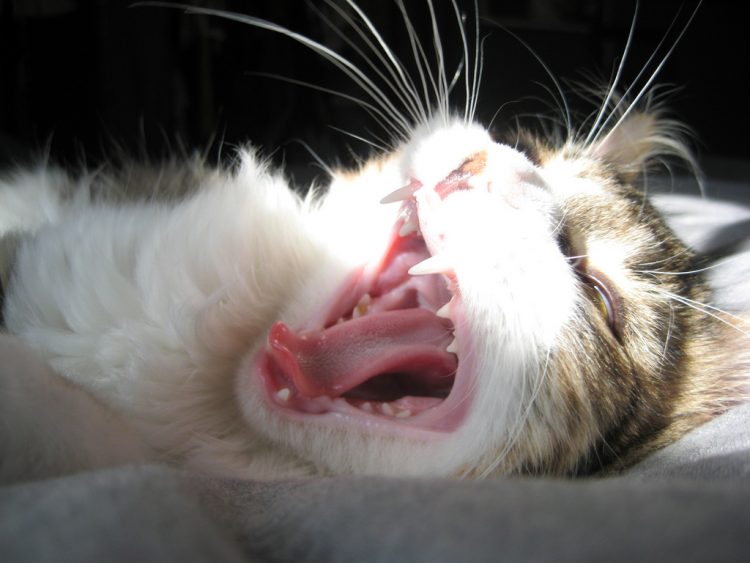
This pet health content was written by a veterinarian, Dr. Debora Lichtenberg, VMD, with contributions from Dr. Pippa Elliott, BVMS, MRCVS. This article was reviewed for accuracy by Dr. Elliott and was last updated on July 11, 2024

- Identifying Feline Stomatitis Symptoms
- Cat Gingivitis vs. Stomatitis
- Why Does My Cat Have Stomatitis?
- Diagnosis of Cat Gingivitis and Stomatitis
- Symptoms of Cat Gingivitis and Stomatitis
- Causes of Cat Gingivitis and Stomatitis
- Full-Mouth Extraction for Cat Stomatitis
- If Your Cat Is Diagnosed With Stomatitis
- Prevention of Cat Gingivitis and Stomatitis
- Ivan the Python’s Story
- Frequently Asked Questions (FAQ)
- References
Identifying Feline Stomatitis Symptoms
Several times a year, someone brings me a sweet, furry feline with a not-so-sweet-smelling mouth. The cat’s breath often clears my waiting room. Clients usually make the appointment because of the foul odor. The cat may also have difficulty eating, mouth pain, or be losing weight.
These symptoms suggest the cat may be suffering from feline stomatitis, a painful disease of the mouth. Many people think their cat needs “a dental” and feel guilty for neglect. However, stomatitis is more serious than simple dental issues.
Key Symptoms of Feline Stomatitis:
- Foul-smelling breath
- Difficulty eating
- Mouth pain
- Weight loss
Treatment often focuses on control rather than cure, aiming to keep the cat comfortable and reduce soreness.
Cat Gingivitis vs. Stomatitis
As they age, most cats develop some gingivitis. Home care such as brushing, dental diets and treats, and routine cleaning should help control the problem.
Gingivitis:
- Affects the small amount of tissue (gingiva) surrounding the tooth.
- Cats with gingivitis are not usually in a lot of pain.
- Managed through brushing, dental diets, treats, and routine cleanings.
- Learn more about some gingivitis in cats.
Stomatitis:
- Affects the entire mouth.
- Causes severe pain, inflammation, bleeding, and infection.
- In the worst cases, the inflammation extends to the roof of the mouth and down the throat.
- The tissue surrounding the rear molars can be extremely swollen, smelly, and very painful.
- The cat may stop eating and exhibit bloodstained fur from drooling bloody saliva.
Cats with stomatitis suffer significantly more than those with gingivitis. Treatment focuses on keeping the cat comfortable and reducing the soreness.
Why Does My Cat Have Stomatitis?
Stomatitis in cats is thought to be immune-mediated. This means these kitties have a strange inflammatory reaction to their own teeth, specifically the plaque on their teeth. Because plaque lives on the tooth, and it is truly impossible to keep a cat’s mouth free of plaque, the teeth usually have to be extracted to solve the problem.
Once the teeth are gone, the mouth usually heals beautifully, and the kitty feels great relief.
Factors Contributing to Stomatitis:
- Immune-mediated inflammatory reaction to plaque.
- Feline viruses, including herpes, calicivirus, and FIV.
Diagnosis of Cat Gingivitis and Stomatitis
A diagnosis of gingivitis/stomatitis is made by visual inspection of the mouth.
Diagnostic Steps:
- Visual Inspection: Primary method for identifying gingivitis and stomatitis.
- Biopsy: Sometimes taken to rule out more sinister options such as cancer.
- Screening Blood Tests: Helps identify precipitating illnesses like kidney disease.
- Dental X-rays: Useful for detecting damaged teeth or retained tooth roots, which may act as a focus for autoimmune activity.
These diagnostic tools help ensure an accurate diagnosis and appropriate treatment plan for your cat.

Symptoms of Cat Gingivitis and Stomatitis
Identifying the symptoms of cat gingivitis and stomatitis early can help in managing and treating these conditions effectively.
Common Symptoms of Cat Gingivitis:
- Red or swollen gums, especially around the inner cheek area
- Bad breath
- Difficulty eating or not eating at all
- Difficulty picking up toys or food
- Drooling
- Plaque build-up on the surface of the teeth
- Calculi/tartar formation
Common Symptoms of Cat Stomatitis:
- Severe inflammation and redness in the mouth
- Bleeding gums
- Foul-smelling breath
- Pain while eating
- Decreased appetite or refusal to eat
- Weight loss
- Bloodstained fur from drooling bloody saliva
- Ulcerations in the mouth extending to the roof and down the throat
Recognizing these symptoms can help you seek veterinary care promptly, ensuring your cat receives the necessary treatment to alleviate discomfort
Causes of Cat Gingivitis and Stomatitis
Understanding the causes of cat gingivitis and stomatitis is crucial in preventing and managing these conditions.
Was YOUR Pet Food Recalled?
Check Now: Blue Buffalo • Science Diet • Purina • Wellness • 4health • Canine Carry Outs • Friskies • Taste of the Wild • See 200+ more brands…

Causes of Cat Gingivitis:
- Poor Dental Hygiene: Lack of regular teeth cleaning leads to plaque and tartar build-up.
- Old Age: Older cats are more prone to dental issues.
- Autoimmune Diseases: Conditions where the cat’s immune system attacks its own tissues.
- Diet: Soft food can contribute to plaque accumulation.
- FeLV (Feline Leukemia Virus): Infection can exacerbate gingivitis.
- Crowded Teeth: Misaligned or overcrowded teeth can make cleaning difficult.
Causes of Cat Stomatitis:
- Immune-Mediated Reaction: The cat’s immune system attacks the plaque on the teeth.
- Feline Viruses: Herpes, calicivirus, and FIV can contribute to stomatitis.
- Bacterial Infections: Bacteria in the mouth can lead to severe inflammation.
- Genetic Predisposition: Some cats may be genetically more prone to developing stomatitis.
By understanding these causes, you can take preventive measures such as maintaining good dental hygiene and regular veterinary check-ups to help reduce the risk of your cat developing gingivitis or stomatitis
Full-Mouth Extraction for Cat Stomatitis
The easiest way to understand this nasty feline problem is to think of the cat’s teeth as enemies of your cat — the gums are attacking the plaque and the tooth. “This is my territory,” says the mouth to the teeth. “This mouth won’t call victory until you enemy teeth are eliminated.”
Extraction Process:
- The extent of the extractions can vary. Some cats may need only some of their teeth extracted, usually beginning with the rear molars.
- Your vet may choose to do the extractions in stages, as every case is different.
- A veterinarian may refer you to a veterinary dentist.
Challenges in Extraction:
- Feline teeth can be difficult to extract and can break easily.
- Tiny tooth roots, if left behind, can continue to act like foreign enemies.
- Dental X-rays are ideal to verify that the teeth have been removed entirely.
- Removing cat teeth properly and with the least amount of trauma is more of an art form than extracting canine teeth.
Common Objections:
- Objection: “But he won’t be able to eat!”
- Reality: Oh, yes, he will. And without pain.
- Objection: “But he can’t enjoy dry cat food or treats!”
- Reality: Oh, yes, he can. When the mouth is healed, most kitties will be gumming those tasty temptations to their mouth’s content.
For many health reasons, however, canned cat food is still recommended for the bulk of the diet.
This adorable cat is surprisingly calm during a thorough teeth-brushing session:
If Your Cat Is Diagnosed With Stomatitis
This is a painful condition for your cat, and he needs your help.
Steps to Take:
- Seek an Opinion: Consult a veterinary dentist if you are shocked by the idea of a total mouth extraction.
- Consider the Cost: While the process can be expensive, it can give your cat a new lease on his remaining nine lives.
- Medications Post-Extraction: A small number of cats may need medications even after their teeth are extracted. These kitties generally need less medication than before the extractions and still live a life free of intense oral pain.
Prevention of Cat Gingivitis and Stomatitis
Key Preventive Measures:
- Good Health: Keeping the cat in good health helps strengthen the immune system and fight off viral infections.
- Vaccinations: Vaccination against cat flu (herpes and calicivirus) and feline leukemia virus can reduce the risk.
- Dental Hygiene: Observing rigorous dental hygiene can reduce the severity and frequency of flare-ups.
Ivan the Python’s Story
Ivan the Python was a cat, named for his penchant for small rodents. Ivan brought home snakes too, but of the garden, not exotic, variety. Because he suffered from stomatitis, Ivan’s family believed his hunting life would end once we extracted all of his teeth. But within one month of Ivan’s oral surgery, he was still Ivan the Terrible to his local rodent population. His mom was finding Ivan’s favorite calling card all about the house again: mouse heads.
Learn more about why cats bring dead animals like mice in their favorite calling card.
Disclaimer: I love rodents too, but there is something called the circle of life, and there will always be Ivans in the food chain.
Frequently Asked Questions (FAQ)
How to treat cat gingivitis?
Cat gingivitis can be treated with regular dental cleanings, good oral hygiene practices, and in severe cases, antibiotics or dental surgery.
How to treat cat gingivitis at home?
Home treatment for cat gingivitis includes regular brushing of your cat’s teeth with a cat-specific toothbrush and toothpaste, along with providing dental treats and a proper diet.
How to get rid of cat gingivitis?
To get rid of cat gingivitis, maintain consistent dental hygiene, schedule regular veterinary cleanings, and address any underlying health issues.
What to feed a cat with stomatitis?
Feed a cat with stomatitis soft, high-quality canned food to minimize discomfort and ensure proper nutrition.
How long can a cat live with stomatitis?
With proper management and treatment, a cat with stomatitis can live a long and comfortable life.
How to treat cat stomatitis at home?
Home treatment for cat stomatitis involves maintaining oral hygiene, using prescribed topical treatments, and providing a stress-free environment, but severe cases require veterinary intervention.
References
- “Gingivitis stomatitis in cats.” Williams & Aller. Vet Clin North Am Small Anim Pract, 22: 1362–1383.
- “Chronic stomatitis in the cat.” Gaskell & Knowles. Veterinary Annual. 28th edition. 246–250.
- “Gingivitis in Cats: Symptoms, Causes & Treatments.” Mooresville Animal Hospital. https://www.mooresvilleanimalhospital.com/site/blog/2022/09/30/gingivitis-in-cats-symptoms-causes–treatments
- “Gingivitis and Stomatitis in Cats.” VCA Hospitals. https://vcahospitals.com/know-your-pet/gingivitis-and-stomatitis-in-cats



